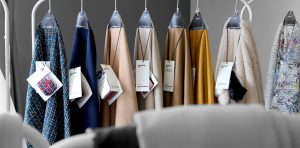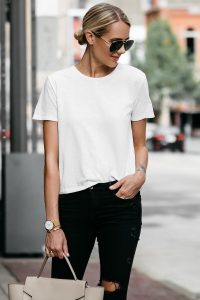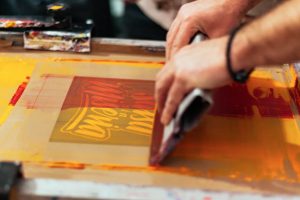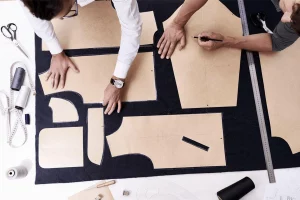
DESIGNING CLOTHES
Before we unravel how designers design clothing, let us advise you on the fundamentals. It is imperative to understand how commerce and creativity work together. While commerce helps keep the light on by generating sales based on current trend data analysis of what customers want, creative on the other hand, grows from intuition on how to express oneself, which hopefully can be appreciated by consumers. Let’s say convincing customers to buy a basic tee or a simple sweatshirt is less challenging than a t-shirt with a print. Why? An image of something on the t-shirt will primarily be associated with physiological values then intrinsic values. We highly recommend combining the two when designing a collection to increase the probability of building a successful brand.
Data on the commerce side is usually associated with what is currently on-trend on the macro and micro scale. It encompasses a style or silhouette trend, guiding the season’s popular shapes, fabric, color, general vibe, and mood of your target customers to help you create the best products with a higher probability of selling. Creativity is about art, which includes a sense of style, swag, attitude, confidence, and the capacity to understand what others will want once you create it. As a fashion designer, this can give you an edge, but trade lightly as it can also backfire on you. Start small or survey your customers for anything that feels too risky; only then is it wise to double down on winners. Like everything else in life, as you gain more experience, your intuition becomes better.
Success relies on being current with trends. Be careful when designing clothes too far ahead of the curve, as you can lose customers’ interest. There is also this misconception amongst some designers about the meaning of being creative. One thing is for sure; it is not squeezing tons of sh** on a garment and calling it remarkable. Instead, it’s having a talent for simplification, styling, merchandising, and creating a mission that captures your customer’s imagination. Position yourself just ahead of the fashion trends by paying attention to the general mood of the market. Although it is pretty hard for most small brands to analyze this data, AVmade.com has a service that helps exec members get insight ahead of the market.
Another consideration to make as an entrepreneur is that your job is to understand what resonates with your customers. It is tough to master the balance between commerce and passion, but you must carefully edit your clothing designs to build your brand. If your goal is to be boundlessly creative without keeping customers’ needs in mind, then good luck! Our advice, get ready to eat ramen noodles for a while or perhaps forever. To give you an example, right now, almost every influencer you see in a magazine, social media, or just living life at your favorite hangout spot is rocking leggings. Heck, even animated moms on children’s shows are rocking legging instead of denim! If a designer ignores the market dynamics to pursue leather pants, they may struggle to generate sales. Plus, customers have shifted towards sustainability and no animal cruelty values. Now imagine the likelihood of the brand designing leather pants succeeding? Therefore it is wise to take what’s on-trend and build on top of it or around it. Successful fashion designers identify what is cool now and what will likely be ‘in’ trends soon. Again, it would help to think about what is practical for most consumers to wear according to your target market.
Entrepreneurship is like choosing a specific career path; it is not for everyone. Your willingness to pay attention, accept harsh criticism, learn, and continue to improve on your skills is part of the career path. The ability to stay focused will undoubtedly put you in a different caliber than most other clothing designers. Our advice, don’t pursue a career in fashion for the glam and glory. If so, you most likely won’t cut it. There will be many self-doubts, frustration, trial, and error before your brand thrives.
6 DESIGN PROCESSES YOU MUST MASTER
This is not up for debate, you must master the following,
- Concept board
- Merchandising
- Editing
- Customer survey
- Manufacturing
- Launching
I. CONCEPT BOARD
What is a concept board?
A concept board refers to a clothing design board with all your inspiration and ideas as a visual guide to help you create a collection. It also enables you to realize the visual consistency your clothing brand must have. This concept board usually starts with many inspirational items, most of which are not even related to clothing. An example can be:
- Drawing inspiration from the color of a car or the shape of a specific model
- If you’re designing a retro collection, so maybe you’re thinking about concepts from the ’70s
- Artwork that serves as a color palette inspiration
- Iconic figures like old Hollywood actors or actresses may represent the vibe your clothes designs convey to consumers.
When adding to a concept board, there is no right or wrong; whatever moves you as a fashion designer since you will later edit.
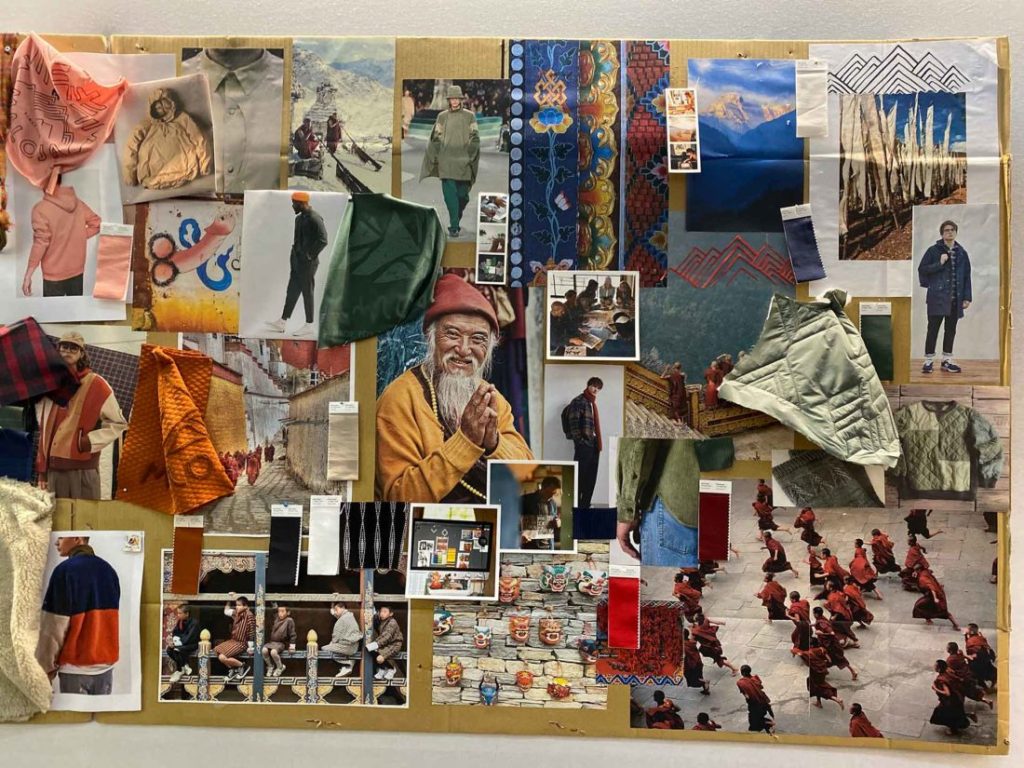
How to create a concept board?
There is no such thing as the ‘best way’ to start a design concept board. It’s typically a process that requires a back and forth and multiple iterations until the designer finds an exemplary anecdote that tells their inspiration. For example, a straightforward way to visualize this idea is to think of ‘Tesla.’ Now, imagine all the different car models they offer in terms of aesthetics. Next, compare those visuals with the designs from car companies like ‘Ford.’ Now, imagine if a few of Ford’s truck designs were to be part of the Tesla collection? It’s obvious even for a non-designer to immediately identify the Ford automobiles do not fit. It’s not to say there is something wrong with the Ford car aesthetic, but to throw them into a brand with a distinct design aesthetic as Tesla’s would leave Ford trucks feeling like they do not belong. To craft a well-put-together concept board, you have to learn how to edit out the Fords from the Tesla. But do remember concept board equals merchandising, and merchandising equals color and silhouettes. This means your color story also needs to be on point. The last thing you want when you create a collection is confusion or clash. You’ll need to implement this discipline whenever you start your clothing brand or create a collection.
The lack of proper merchandising is the main reason brands tend to lose customer interest. We humans subconsciously gravitate to more cohesive things. When customers visit a store, they need to sense cohesiveness, not visual chaos. If a customer visits your store because of your marketing effort but is NOT super excited after their first visit, then chances are it will be tough for you to get them to come back. It is vital to have a clear identity that is aesthetically pleasing and cohesive to your target customers right the first time. When your brand gives customers the overall wow experience from design to merchandising, it leaves an excellent impression. It creates inspiration and excitement in the customer’s memory. Therefore, not only will they come back, but also there is a great chance they will become brand ambassadors and tell friends about your clothing brand.
Now, when you begin to put together your design concept board, start doing all the research you can. Include online and offline resources such as magazines, Instagram, Pinterest, and any other form of inspirational medium. The process of gathering data and information starts by:
- Thinking deeply about what it is that you want to say in this collection. Ex.
- Are you inspired this season by a place like Cali or Dhali?
- Or is it more to do luxury lounging in Malibu or Santorini
- Or is it NY streetwear?
- Or none of the above. Perhaps it is about tropical
- Or nature
- The sky’s the limit. But do choose and build around that concept.
- How can you enhance your inspiration tastefully?
- Colors composition drawn from the environment you chose as a building block
- Silhouettes assortments that fit the vibe you’re going for.
- How can you educate consumers about your brand?
- Who are you?
- Why do you do what you do?
- Why you and not the other brands? and so on
Spoil alert, there isn’t anything that hasn’t been created by someone in the fashion industry. To think otherwise is pretty much a clichéd joke by now. The bright entrepreneurs will identify trends and merge their designs within their current collection mood board rather than reinvent the wheel.
Now, you know better, stary by gathering all the pictures and visuals you need to start a collection board. Put everything you like on the board, and we will teach you how to edit carefully next.

II. EDITING
How to edit your designs?
There is not a right or wrong answer to this process either, and also, there is no magical number of clothing to present in a collection. It is like asking someone how much weight should I bench press? Well, depending on how long you have been going to the gym, how strong you are, and whether or not you have been practicing. If you are new or have budget constraints, then you may be able to do only 3-5 styles. But if you have tons of experience and the capital to back it, then you can start with 15-20 styles. One thing is for certain, as we have seen it over and over, the number of styles does not determine someone’s success.
So to clarify this answer for fashion design entrepreneurs, let’s begin with the basics.
When you edit your clothing designs, that means you are extracting anything that does not fit in terms of aesthetic, color, and merchandising. But you are also narrowing the number of pieces (styles) you’re going to release, which will be based on the stage of your brand. If you are reading this, it means you are either a Startup or an Emerging Brand, so let’s dive into it :
STARTUP FASHION DESIGNER’S
As a startup fashion designer, there is a learning curve that you need to overcome to make sure you understand who your customers are and what your customers want from your brand before you start throwing a bunch of darts on the board to see which ones will stick. Initially, we see more savvy individuals begin by experimenting with no more than 3-4 styles. Rare but possible, we’ve seen entrepreneurs who understood their customers so well they started with 15-20 pieces. Building a brand is a process that has to be implemented incrementally.
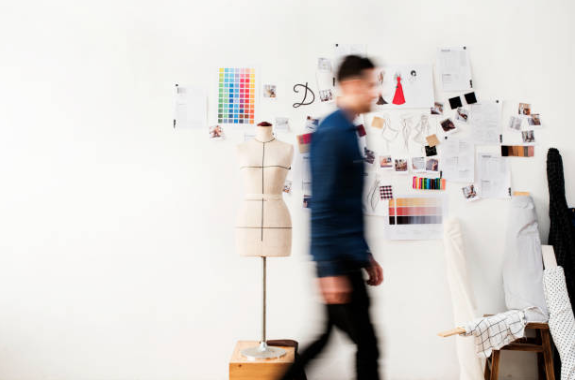
If you’re not confident because this is your first rodeo, and you lack industry experience, then you should start conservatively. The best answer for you would be to start with a few styles, say around 3-5 pieces, and a couple of colorways each that would best work for your ideal customers to begin your case study. Small steps.
EMERGING FASHION DESIGNER’S
If you have been in the industry and growing steadily, then you can either do:
- Extensive collection 15-20 styles seasonally (4-5 times a year) and replenish as you sell out or
- Small Capsules of 8-10 styles 96-8 times a year
In every collection, we will advise you to add a couple of new silhouettes to test and see which piece will become your brand staples. Remember also to note which colors and styles do the least and eliminate based on sales-through. Now, make sure to control the clothing design process and never get ahead of yourself. Make sure you have a marketing dollar and development capital to test new styles. Every time you add a unique style to your store, you must ask;
- Why will I add this style?
- Will it work for my customers?
- Is it cohesive to my overall brand aesthetic?
- Will it drive new customers?
- Will it compliment my current store assortments aesthetically?
- Does the price point fall within my customer budget? Ex, if you are selling a t-shirt for $30-35, but now you’re bringing another t-shirt that is $50-55, it may be hard to justify it. On the other hand, buying a cropped tee for $25-28 or a sweatpant that is $90-98 for a customer who pays $30-35 for a t-shirt may be a great fit.
To further clarify this process, let us show you an example. Let’s say you have 100 Loyal customers who buy products like tees from your brand. You are now expanding your brand by adding a new category of sweatpants, sweatshirts, and leggings. Your effort may or may not translate into success if you use only your existing customers to test these newly added styles, even though a brand that sells t-shirts alongside sweatpants will be considered cohesive. But when it comes to testing your new concepts, you should ask these two questions.
- Will your current customer base buy these newly added styles?
- You are trying to expand your customer base by enticing new customers.
Once you answer the questions above, then you should let your existing customers know. But also implement the same marketing process you’ve used to acquire your 100 customers to test this new product on a different cohort.
The key to building a successful clothing brand is by experimenting carefully and slowly building your brand, customer base, and staple pieces carefully on a step-by-step process, as we’ve explained above. Eventually, the aggregation of these winning styles will fill your store in due time and increase your sales with both existing and new customers.
To clarify, remember to follow this advice:
- Experiment with a few key clothing pieces that are cohesive
- Keep bestsellers as part of your ongoing clothing collection
- Let go of styles that do not sell
- Rinse and repeat your marketing process with a few styles
How experienced designers edit their collections?
It is difficult for experienced designers to anticipate which pieces in their collection will sell with certainty. But anything that feels like it will be a complex sale, they will move away from it. It is trial and error based, so go with your intuition at first but continue to learn by talking to your customers, gathering data, and observing other successful clothing brands. Experienced designers will constantly re-evaluate their collection, rinse & repeat their process many times over until mastery. Testing your hypothesis and experimentation is how you became an expert.
Once designers get merchandising right, customers can easily visualize themselves wearing your clothing without trying so hard to convince them. It needs to be a no-brainer to customers why they should buy from your brand. Once you establish your clothing brand’s identity through carefully crafted merchandising, your hard work will speak for itself. Keep in mind that even if you have a background working for a fashion designer, building your brand is a whole new world of transition. Sure, you may have some leverage, but you will not master carving out your customer base in your first collection. But in time, once you identify design aesthetics with customers’ validation, this will be the beginning of something remarkable.
Think of it this way,
- Once you know your target audience
- What your potential customers shop for on the regular, and
- Can you offer an even better alternative? If so, you and your team will find the editing process and success faster than your competition.
III. MERCHANDISING
After accomplishing your goal, which was to create a design concept board and edit, here is where it gets interesting. Merchandising is a very crucial and essential part of the process. Merchandising must be part of your thought process starting day one of creating your concept board. Here is where you need to concentrate :
How to best merchandise your collection?
Merchandising a collection means making sure you have the following strategy adequately implemented.
- Does the color story work?
- Is it sellable?
- Is it cohesive?
- Does it increase the overall customer’s enthusiasm in your store? Which then translates to maximizing your transaction value per customer.
A perfect exercise to illustrate this point will be to visit your favorite luxurious store and view their most recent collection. You will notice the cohesiveness in colorways, the ability to mix and match, and how it all flows perfectly.
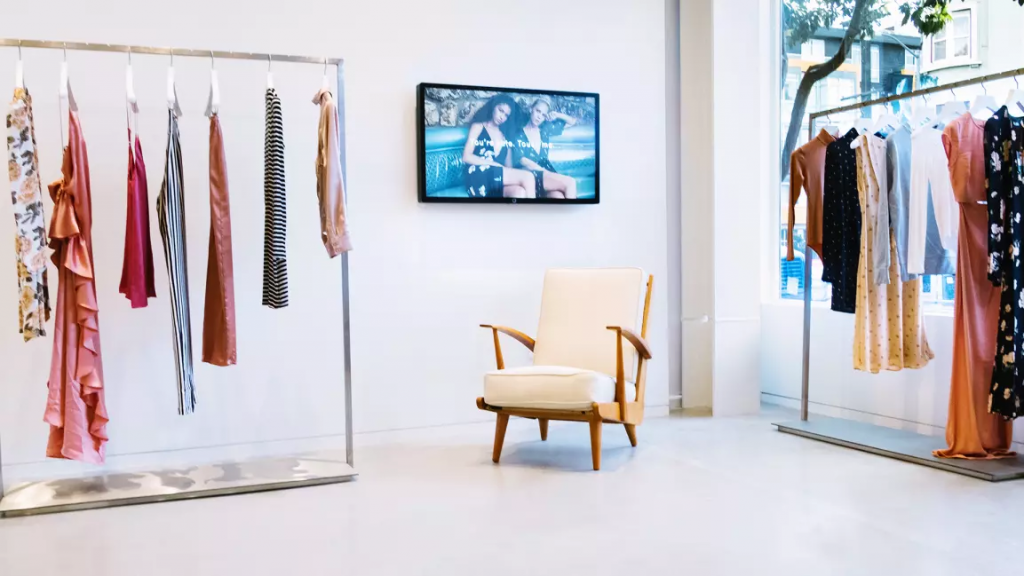
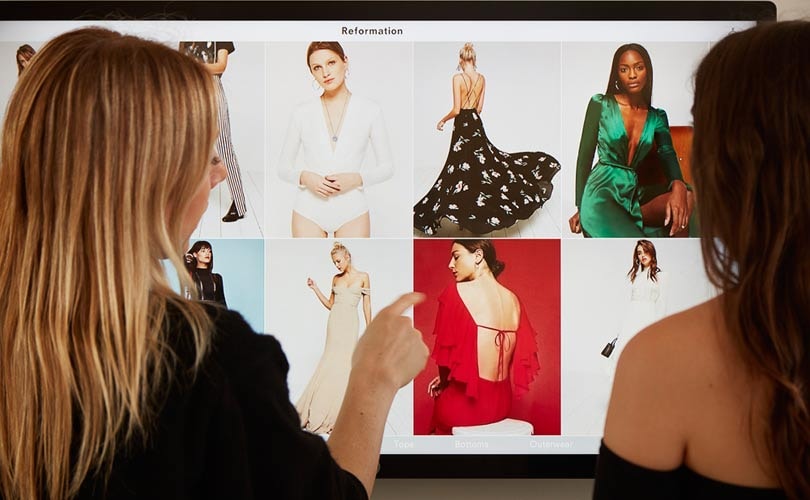
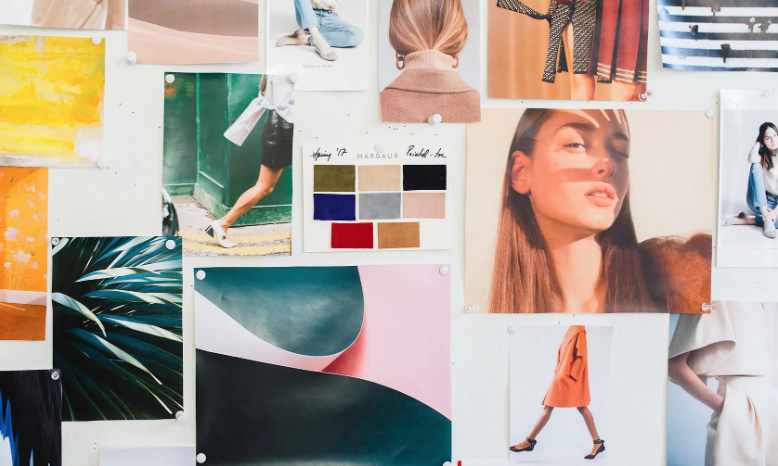
It looks phenomenal because of the way it’s color-coordinated with high-res images displaying the items in vibrant hues. Entices customers to add multiple items into the cart without persuading them with coupons and discounts.
As discussed earlier, merchandising starts by evaluating the concept boards to identify:
- Which pieces in the collection work as an outfit?
- Colors that complement each other and the season.
- How to display items together that are visually appealing as a group?
Carefully editing a concept board has the power to drive more sales since a precisely edited board can show shoppers how items work together. Customers will buy a few more pieces when shown ways to transform each piece into a new outfit. After purchasing, they leave with joy because the styles they purchased are cohesive. Mastering this process is the key to your success. Applying design editing correctly and learning to build a story within the concepts is a road map for victory as a founder. Btw there is also a collection board on AVmade Design Studio where you can add products to help you with merchandising.
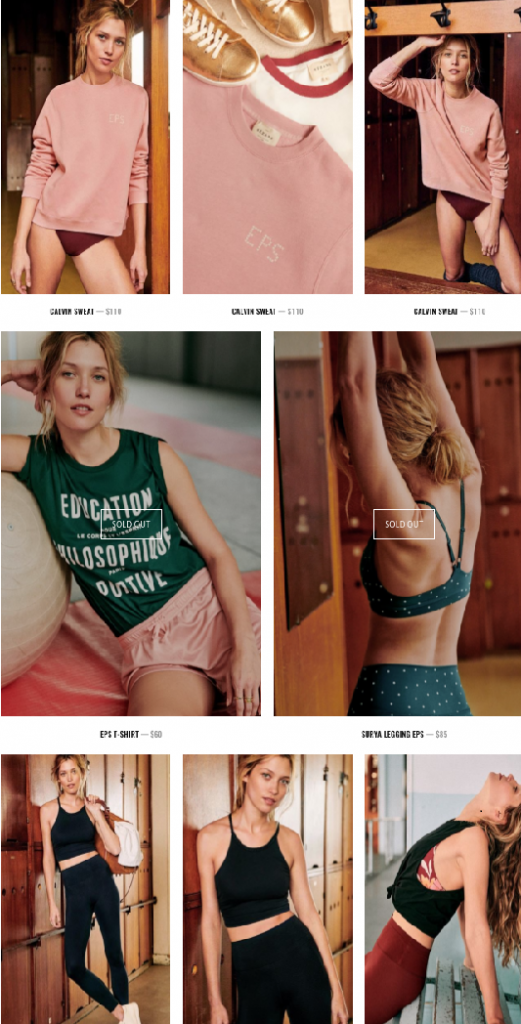
IV. CUSTOMER SURVEY
How does surveying help you make the right decision?
Here are some ways to improve and narrow your focus during the design process before investing in inventory.
- If you’re working within a small budget, you can’t do production for all products you’ve envisioned due to cost. Instead, either get samples made or license the image from AVmade Design Studio to survey customers first.
2. Once you pick your strategy, put together your content plus questionnaire, and get ready to survey customers using software like ‘Survey Monkey. Make sure you run your survey using potential customers, not random individuals. It has to be a suitable customer based on the psychographic and demographic of your brand. NEVER generic individuals. Surveying random people that would not naturally be a customer would be counterproductive.
3. Keep pricing in mind when identifying your customer base.
A. For example: targeting all women between the ages of 22-32 who live in urban cities and love streetwear does not translate to success. It would be best to dig deep to understand more about your customer budget for similar quality products, where they shop, places they like to hangout and things they like to do.
4. The factories on AVmade.com offer various sample types as low as 85% less than traditional factories to help our brand partners experiment wisely.
Do anything to help you further understand and identify the type of clothing designs, vibe, and customer base to build a successful brand cost effectively.
FYI: You can not use Factories images from AVmade.com to survey or sell garments without AVmade.com authorization. Doing so without permission constitutes plagiarism and theft, and it’s a felony.
How to survey customers to start to design clothes?
First, pick a software like SurveyMonkey, google form, google survey, or anything similar to list your question and gather data. Keep your questions simple and, if possible multiple-choice based, time is money. For starters, ask some of the following survey questions to identify your demographic group better.
- Which styles are your favorites?
- What price point will you pay for a designer brand with high quality? Offer three different price points to choose from if you want to make it a multiple choices’ questionnaire. (It is tricky since many people love to lowball everything, but give them reasonable options to avoid any hidden bias.)
- What type of brands do they regularly shop? (This can also give you clarity on the kind of price points these shoppers expect to pay.)
- What items do you buy frequently? (It is further proof of their spending budget.)
- Any other questions you think are helpful. But do keep it a 5-8 questionnaire and make it a multiple choice if possible. Keep in mind, like everything else, your questions will also improve through trial and error as you build your brand.
Remember, nothing in life is free, so asking someone to take a survey is no different. It may cost you a $5 Starbucks or Amazon gift card reward to draw participants, but the data will be worth it. So if you invest a couple of hundred bucks initially before you invest thousands, image.
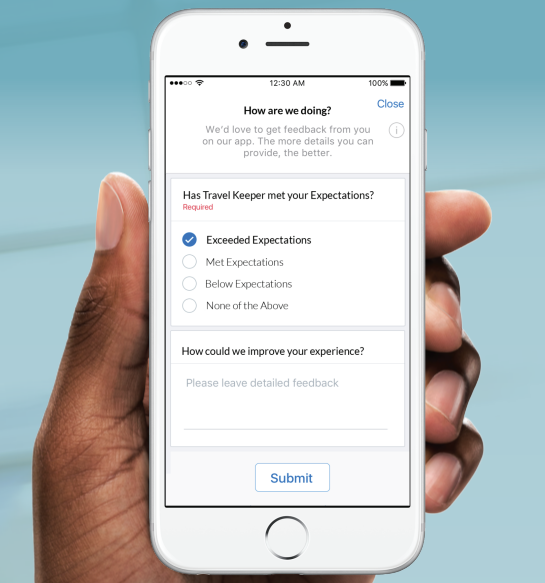
Remember, no one becomes a millionaire overnight, but those willing to learn and understand their customers will eventually outperform everyone else. Also, avoid the headaches and the enormous financial burden as well. Always think long-term. Becoming a business-savvy individual means understanding what your customers want on every level and continually learning to listen to what your consumers want. It helps to put yourself in your customers’ shoes to understand their ever-changing needs and be willing to listen carefully and work effortlessly to move the needle in the right direction.
If you are looking to build a quality brand with the elite factories in the USA, then AVmade Design Studio will be your go-to place. You can design and manufacture quality products with low MoQ on AV.
MANUFACTURING
How to find a clothing manufacturer?
Just like money, clothing does not just grow on trees. To get the best for your buck, you will need to find factories with superb quality. Otherwise, you will end up with products you can’t either sell or be proud to sell. We (AVmade.com) only partner with the elite factories in the USA that are either vertically integrated or full-package capable. We make sure no middlemen are allowed on our platform to maintain quality and price. Factories on our platform Join for free, and even further, we take over their sales and marketing effort for a 10% fee, which used to cost them 35-50% of their gross. Our factory partners can now help our brand partners reduce costs, be flexible with MoQ and provide incentives. You can digitally create on AVmade any product as made-to-order with specs of fabric, fit, color, size, finishing, and dozens of design tools. Designer brands now have an excellent opportunity to stand out and make their mark as one of the best-emerging brands.
Another way is to source a factory on your own. It is pretty complicated establishing relationships with high-quality clothing manufacturers, and it is almost impossible to find a high-quality clothing manufacturer willing to work with emerging brands. Some of the challenges are that most factories will need to account for overhead and expenses, and frequency. To breakdown what this means;
- Given the size of staff and facility, a well-established factory sees minimal opportunity to develop a brand. Remember, 80+% of emerging brands give up and move on, so taking a risk for them is risky.
- They have to keep their production at a capacity at all times to meet their fiscal sales goal. Otherwise, they will work on a deficit. The bare minimum most factories will allow is around 300-500 units per style.
- Most emerging brands do not have a program. A program is a pre-set schedule for ongoing production that the factory can expect from brands. EX: brand X makes a t-shirt and sells about one thousand units monthly. So brand X can guarantee the factory a thousand units monthly. But since most emerging brands take time to develop their sales and grow, most factories hate dealing with the unknown. Therefore if you have no program, then the factory will prioritize you the least, that is, if they take you. Unfortunately, that is not the best roadmap to keep your customers happy.
Finally, AVmade relies on the extensive relationships and database we built for over a decade with the elite clothing manufacturers in the USA. Given our domain expertise in the apparel manufacturing industry, we have proven models that help factories become more efficient and scale significantly. As a design studio for designers and emerging brands, we make the impossible possible, and we love doing it. You can now design and get high-quality products made to order by the best factories in the USA all in one place digitally. Lastly, our system and strategies will slash your development fees by 85% and production costs by 30-40% compared to traditional factories. You can manufacture any clothing design you want with very low MOQ with state-of-the-art design tools.
Since all factories are made-to-order, you will always be able to replenish what you need without the need to compromise.
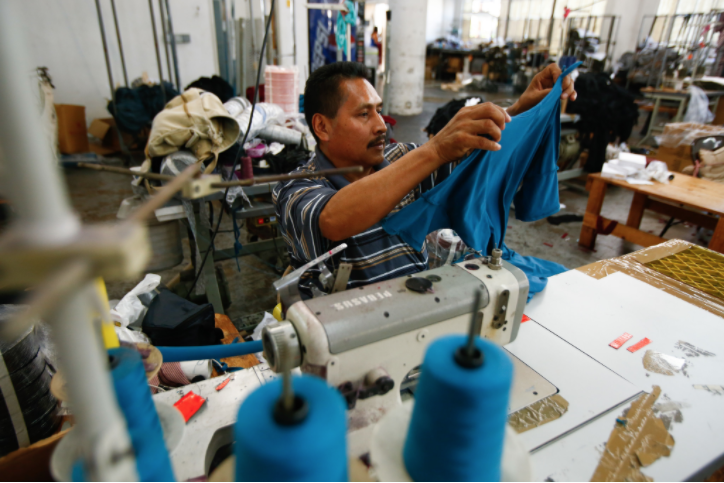
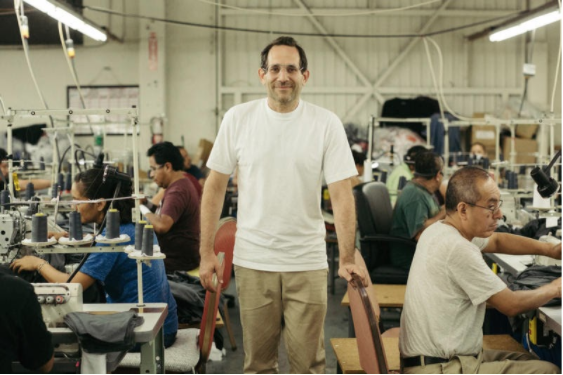
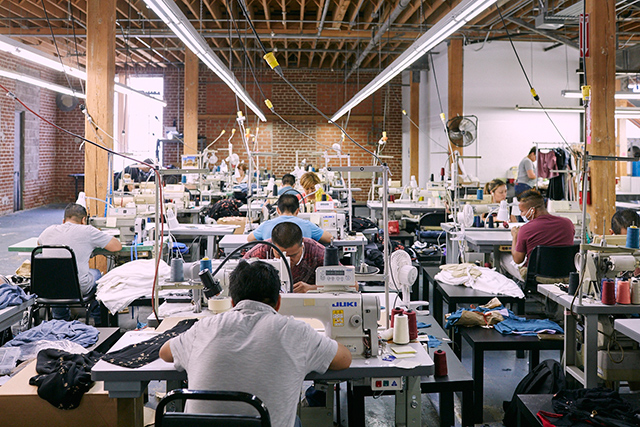
VI. LAUNCH
Build a platform to display your creation.?
Here are some additional strategies you can plan today to create an aesthetically pleasing website on Squarespace or Shopify. To start building your brand identity, you can either learn to do it yourself for a couple of weeks or hire someone for a reasonable fee.
Make sure your product images showcase your products to resemble something a high-end store. It takes less than most agencies charge if you know how to grind to put it together yourself. But still expect to spend 2-3K on the shoot since it is critical to put together a team of professionals. Unfortunately, if you have to use an agency, then expect to pay 5K+. Shortcutting talents will result in mediocre and cheap outcomes. Even if you sell superb quality, it will be impossible for a customer to know this information without an excellent quality image. You will also need a system for a structured description of the products you’re selling to remove all UX/UI frictions. If you need help, let us know; since we offer our designer partners free consultation, we will be happy to help. Ultimately, you must provide customers with an exquisite experience to form trust and a long-lasting relationship. Remember, no excuses since a failure here only demonstrates a lack of determination from your end. You can control your branding, so be your own harshest critic and grind!
Moving forth, put yourself in the customer’s shoes, and ask the tough questions. Keep in mind when you set out on your brand building journey, you must:
- Create a cohesive well-merchandised collection
- Be consistent in your approach and messages
- Display a unified color story within store’s pages
- Everything you do, do it with your ideal customer in mind
The general mistake we usually see with startups is not knowing their ideal customer base. Suppose you have clarity about who your customers are before you start your collection. In that case, the design should come to you very naturally, and so does the color selection, merchandise, price, and overall storytelling. Work relentlessly to build a winning strategy within a well-thought-of comprehensive plan. You can always contact us to help you put together a comprehensive plan.
CONCLUSION
The game was rigged for years to benefit those with significant capital and inherited networking until we came into the picture. The entrepreneurs who approach their clothing brand with the long-term in mind will always win, and we will continue to fight for you. Use your ingenuity to make sure you stay ahead of the game, on-trend, and build customer loyalty every chance you get.
The “AV-Team” is on the mission to help our design partners achieve:
- Digitally design manufacture anything they want
- Quality products
- Low MOQ
- Hassle-free clothing manufacturers process.
We want our platform to be an ecosystem to be the fashion entrepreneur paradise. We’d love to assist you in any way we can and continue to help you build a successful clothing brand. Contact us if there is anything we can do.
3 REASONS TO START CLOTHING LINE
- Opportunity
- Vision
- Mission
I. OPPORTUNITY
How to seize an opportunity to start a clothing brand?
Why the Source of the opportunity may not matter since sometimes the unexpected can surprise you, but what’s important is recognizing how seizing an opportunity can help you build a successful brand.
We’ll give you two examples that can show you how some of the most successful clothing designers have managed to seize this opportunity.
- Designer Yael Aflalo struggled to build her brand called “YA-YA” as a wholesales brand selling to corporations such as Urban Outfitters until she gained unexpected inspiration while on a trip to China. Moved by the horrible pollution she witnessed, she saw a gap in the fashion market and shifted into sustainable wearable garments. Do you see what we meant by an unexpected opportunity? Moving on, Yael soon left her Ya-Ya brand behind and started a clothing brand called Reformation. Today, Reformation at its peak was generating around 200M annual revenue, which later was acquired by a private equity firm for an undisclosed amount of dollars.
- J Brand jeans co-founder Jeff Rudes saw an opportunity to create clean, stylish skinny jeans when jeans with outlandish bling saturated the market. Being a stylist who was constantly in a chat with customers, the co-founder in charge of creative understood there was a much-needed demand for clean-cut denim. J Brand was born to cater to a niche market as an alternative to bling which later replaced the entire bling market. They grew their business to generate over 100M annually and became a household clothing brand.
Examples like these are a dime a dozen, but one degree of separation makes these brands better than others.
II. VISION
How essential is a vision to start a clothing brand?
It takes a great deal of long-range vision to cultivate the kind of eye that will spell success for new fashion designers building their brand. To possess a great vision, a person must work at it as its experiential base, probably having worked for companies or self though through trial and error to learn the ropes. Vision is intentional and defines a designer’s point of view. It is part of who you are as an artist, and, yes, some fashion designers are artists who need a tremendous amount of support from clothing manufacturers. The strength of clothing brand identity will guide your vision and allow others to latch onto what they find inspiring about the vision you offer the world. Don’t assume visionaries were born with extra power; if that’s the case, we guarantee you only a handful can raise their hand. But instead, it is something you work effortlessly to achieve. Even if we were wrong about most visionaries being born with talent, from our experience, if talent doesn’t hustle, then hustle will beat talent every time.
Now, let’s talk about what uniqueness and inspiration for your clothing designs mean. You have to ask yourself questions like,
- What sets you apart from others in your field as a clothing designer?
- What genre do your clothing design will start its hornet and why
- Who are the icons of the past that you idolize, and why?
- Read about founders of most fashion households, see their stories, and form more Q&A for yourself.
Answering these questions will allow you to mold your unique story and offer consumers glimpses into your mind. Remember, not everyone sees things from your point of view. Therefore, guiding clients through your process and inspirations using familiar references makes it easier to build your brand. Whether you are merging athletic wear with feminine touches or taking androgynous clothing designs to the masses, you need to have a unique artistic vision to inform customers and explain the reason behind it.
Defining your vision is critical. To have a vision that can easily be understood could translate to commerce. Be careful being over the top in your designs, as it can backfire on you. Learn to edit your vision if it is too far out there. Find ways to simplify and communicate that vision with customers. Having a carefully developed and fine-tuned vision is everything; it is what separates true visionaries from wannabes.
III. PASSION
How to turn your passion into a clothing brand?
If you have been passionate about starting a new clothing brand and found yourself constantly flowing with ideas, hoping and waiting for the right time, then you are the right person to give it a shot now by starting a clothing brand. If you make your passion a career, they say you’ll never work a day in your life. So why not capitalize on that extreme passion and leap into having your dream job?
Most passionate creators find themselves immersed in a single pursuit, daydreaming about it all the time. If you’re constantly occupying all your free time creating digitally or at home, then that is what passion is all about. So much so that the most passionate individuals will get in such a zone, they will lose track of time when they delve into those moments. Although being passionate doesn’t mean you’re good, constantly training your mind will shape your talent. As we said above in VISION, “if talent doesn’t hustle, then hustle will beat talent every time.”
Fear can be the most significant setback to people’s dreams, but working with AVmade Design Studio will give you that extra boost of confidence you need. There has never before been an ecosystem that sets designers for success as AVmade has. If you break the barrier of fear, you will most likely find a path to win, and we will do all we can to help.
6 QUESTIONS BEFORE DESIGNING A COLLECTION
- Brands I like
- Brands I relate to
- Brands I support
- Demographic target market
- Gender to start with
- Point of view
I. BRANDS I LIKE
How to leverage the brands I like?
You start by listing the brands you like, either brands you wear or brands you aspire to wear if you could afford it? This way of thinking allows you to understand:
- Silhouettes types,
- Design details,
- Reasons why you like them or is it because SMM
- Their product assortments
- How are they merchandised?
- How are they pricing?
We do not suggest you do what they do. But it gives you a roadmap of how other founders think about their branding framework. Once you have clarity, you can improve on what they lack and architecture your world as you see fit.
It won’t surprise you to know that when most designers decide to start a clothing brand, they think about the type of designs offered by their favorite brands. Therefore, the best way to narrow the process is to create a visual concept board including clothing brands you like and identify their design assort.
You may need to specify certain silhouettes or even designing with a specific gender in mind, which we will talk about below. Be sure to narrow your focus with only your primary target market in mind. It will help you as you set out to build your brand. Remember how we talked about defining your vision? That is what can also guide this objective. If you need to consult and brainstorm with us, we’re always here.
II. BRANDS I RELATE TO
How to identify clothing brands you relate to?
Similar to considering brands you like, you will find it helpful to identify why these brands resonate with you. It would help if you formed your questions from a design point of view or a brand mission. Push yourself to dig in a bit more and do a little more self-reflective thinking rather than just designing clothing. There is more to developing a clothing brand; you need to understand what drives customers to identify with brands before you set out to create clothes. When building your clothing brand, find how other brands established their dominance. By unraveling their secrets, you can begin to iron out the qualities that make certain brands shine, and in return, it gives you an insight and clarity on how to form your brand even more profoundly.
Most experienced founders have a solid framework for building a brand, including technical skills. Learning from the pros is how the student can become a master. Without having a great framework and a roadmap, spending tons on advertising alone to generate sales can only take you far. You will need both verbal and visual mastery to win customers’ hearts. Always think about how the brand you’re building today will look 5 to 10 years from now? Find what makes your ideal customer tick or inspired in terms of your clothing design, brand messaging, and brand mission so you can speak their language and fill their closets!
III. BRANDS I SUPPORT
Why do I support this brand/s?
Since every business needs to have a mission or a value proposition, identifying what you already support and, more importantly, defining why you support these brands will help you shape your message.
Understanding brands you support, their messaging approach will guide you to perfect yours. In this topic, we’ve focused mainly on crafting the strength of your message so your ideal customers can rally behind your brand.
Here are a couple of examples a designer that likes these brands can learn from them.
- Reformation’s “sustainably made” brand’s mission gets customers very excited to buy. Even though there are similar and more cost-effective pricing than Reformation, many shoppers see Reformations’ mission worthy of their support. So, if sustainably-made is your jam, then understanding that component is critical as it might also be something you could incorporate into your marketing and mission statement. But you have to be all in, like ALL IN. TO understand what we mean, visit theReformation.com
- Lauren Moshi’s clothing designs may not take an environmental approach, but because she is a well-known painter, the clothing designs start with strong graphic elements. Her mission is about how she loves being an artist, and her clothing reflects it. Sometimes it is that simple.
- Everlane brand is all about “Radical Transparency.” It means they cut out the middleman and sell directly to consumers at a better price than the competition while maintaining product quality. Plus, they display how much it costs to make and how much they are selling it for under each product description. It is what’s called the best value proposition display. Everlane sells a t-shirt for $25-$30, and there is nothing unique about it. But the way they laid out their infographic for each product made customers feel they were getting a bargain. They took an old concept, “value proposition,” and made it unique and visually appealing for customers to get behind their brand. Go to their site, select any product, and scroll to the bottom to view their infographic.
IV. DEMOGRAPHICS MARKET
Which demographic of customers am I more passionate about?
Many designers find their demographic market easily by designing for their age group and gender. If you are designing for a niche or market that you don’t have first-hand experience in, best if you survey to understand who they are and what they like? Tbh, this is dangerous territory, and we don’t recommend it unless you have years of experience in brand development and identifying new markets. Also, be careful assuming the brand you buy from is catering to you as their primary demographic market. Unless you work for that brand to know their internal data, it is tough to make this assessment concretely. The best way to know you are a brand’s primary customer is your obsession with the brand. Why is this important? Well, if you would say, I’m going to design for customers like me, then best to know who you are.
Let’s say, for example, you’re a 35-year-old who loves shopping from a Reformation clothing brand. Although it may seem like they cater to your demographic as a shopper, there may not. Their primary demographic market can be 21–25, secondary market 26 to 30 & Tertiary Market 31 to 40. Understanding this is critical when it comes down to marketing. Never assume your core demographic market without finding more info; neglecting to do so can skyrocket your CAC (customer acquisition cost) and quickly deplete up your bank account.
As they say in marketing, you first need to go after the ‘low-hanging fruit’ so you build up your cash flow. Make every marketing dollar count; if you can bring your customer acquisition cost down, that means you will stretch every dollar to acquire new customers. It’s crucial to apply this at the early stages of your brand formation. It becomes imperative to do a marketing analysis once you put together a collection and produce your product.
V. GENDER
How to choose a gender to start with?
Finding which gender you want to design for early on is critical. Remember, when trying to please everyone, mostly you end up pleasing no one. The different categories of men, women, juniors, and kids markets mean a chance first to pick one and expand into another in the future. But it’s best if you first pick one gender, to begin with, and stick with it until you build brand momentum. It is shared with particular designers in the loungewear space to create a collection of clothing designs for both men and women when they launch. The loungewear essentials we are talking about encompasses styles such as t-shirts, sweats, and essentials such as these. So to be clear, we are not saying to do unisex clothing, as no designer brand ever does such a thing. Unisex clothing is a way to liquidate cheap products made by merch brands, not designer brands. We still highly recommend you to focus on one gender first.
One hard-fast rule of thumb, if you want to build a brand, avoid trying to sell items as unisex. It is a horrible business practice only accepted in the 21st-century by merch businesses trying to liquidate cheap items. We know it’s a cliché to think a woman would prefer to wear her boyfriend’s t-shirt if she had a better alternative. You might get away with this kind of marketing initiative, but we don’t recommend it. As your clothing brand expands and you start acquiring a customer who has a strong fashion taste and KNOWS a designer produces with her figure in mind, your unisex marketing effort will undoubtedly backfire on your brand. You will end up as the brand she will never shop with again.
The last thing you want is to attempt designing for all body types regardless of male or female anatomy and end up with ill-fitting garments. Bad reviews regarding clothing fit can hurt, especially when shoppers discourage a friend or group from buying from your clothing brand.
Instead, to give you an example, if you’re going after a women’s market but you need a masculine tee that looks great on her, then do what’s called a “boyfriend cut.” So using the example we just gave, understanding there is always a masculine fit product but designed with her body in mind will buy big points for your brand. A designer “boyfriend fit” tee is adequately designed to mimic that boyfriend’s t-shirt look but specifically for her body. Various designs that a female shopper would love and recommend to all her friends that have a masculine structure with a feminine touch will be,
- A boxed cut t-shirt.
- Oversized women’s t-shirts.
- And so much more offer a replacement for the unisex t-shirt.
Always keep in mind, word of mouth is essential for entrepreneurs to build a brand. Let us show you an example of a boyfriend fit from a designer brand vs. a unisex merch brand.
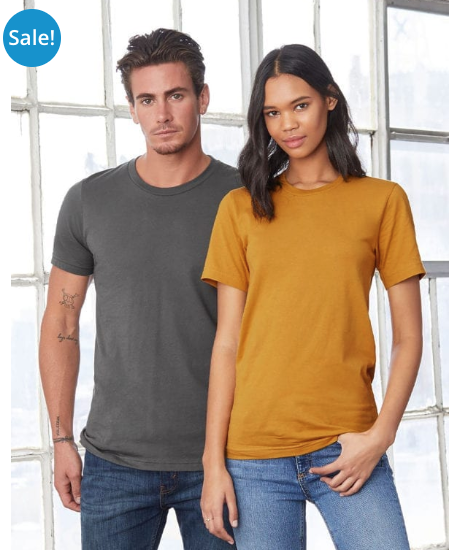
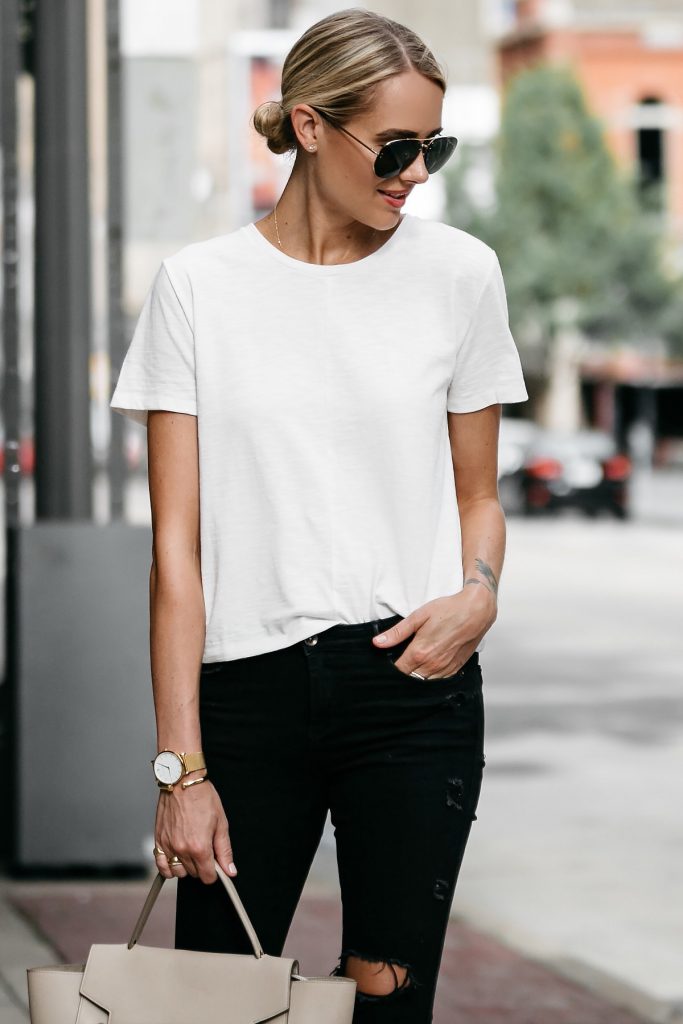
On the flip side, we can imagine most men can barely fit into their girlfriend’s t-shirts, so don’t try to game the system the other way—everything you do needs to be to make your customer feel their best. The more you focus on the quality of your clothing design (cut), the more loyal customer base you will continue to build. Keep in mind the importance of putting customer-centricity front and center, as it is the building block of how successful brands are born.
When customers identify the type of product they should expect from you, don’t throw them a curveball. You always want to be their go-to when they need new items or replenishment. When you earn that repeat customer, get ready for them to bring along great reviews for others to see and word of mouth to fuel up your growth. It is also how you retain customers for a very long time and get the most out of your customers’ LTV (lifetime value). LTV is calculated by the money you spend in marketing or advertising to acquire customers, then divide by how long and how much the customer spends with your brand so far. LTV is the best way to assess what the future holds for your brand in terms of profitability and growth. Remember, clothing brands that get acquired or reach a multimillion(billion)-dollar evaluation will always have a great LTV. Our great effort in describing everything above is to say, please, choose a gender type and design for that specific gender in mind to avoid failure.
VI. MY POINT OF VIEW
How much does my point of view matter?
A point of view can come from anything that inspires you. It may be design-related or mission-related. It is best to ask why me or why this concept? Questioning yourself first will allow you to see if what you are doing or attempting to do is worthy or need further improvement. Do not think of this as an attempt to persuade yourself away from your concept. Instead, this is an opportunity to carefully analyze and make the best choices that give you the most chance to succeed.
Remember, we all like competition as long as we win, so knowing what you’re getting into and seeing if you have a chance of winning is critical in building a clothing brand. Therefore, even if you do not have a point of view that is unique in design, then try to make sure you have a point of view that is unique in its mission or value proposition. Always seek this information to give your business the leverage to go a long way and assure your success.
SUCCESSFUL CLOTHING BRANDS & THEIR MISSION
Here are some examples of different brands with different points of view and missions. It is not to say this is all there is but to show you some examples of looking at brands from a different perspective.
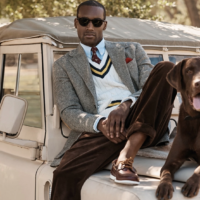


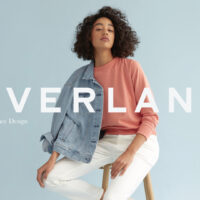
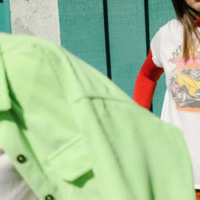
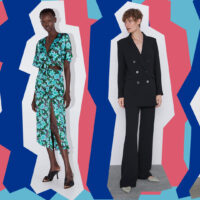
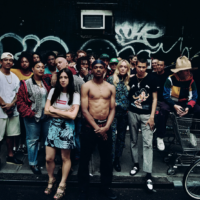
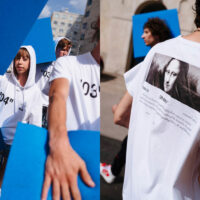
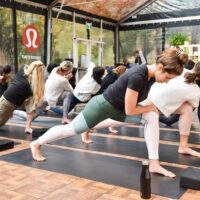
Starting A Clothing Brand Vs A Clothing Line

